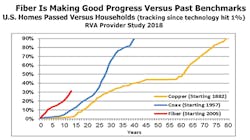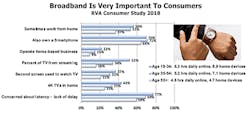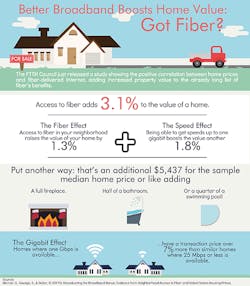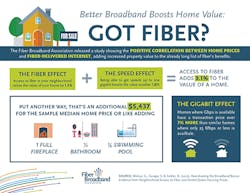History Makes Its Mark on 5G —
This December marks the 30th anniversary of the Fiber in the Subscriber Loop conference — the first conference to focus on Fiber-to-the-Home (FTTH). Held in 1989, hundreds of participants from service providers who had bravely installed FTTH field trials attended to review their expected, and unexpected, challenges along the way. Of major importance was the sharing of fiber architectures and technologies to be deployed in the future.
To put 1989 into perspective: we were still using fax machines; cell phones and laptops would not be embraced by consumers for quite some time. At that time, the communications industry was still linking cities and central offices (COs) together using new high-speed SONET OC-48 connections. The year before, we saw the first 6 fiber optic submarine cable (TAT-8) installation linking Europe with North America transmitting at 280 Mb/s.
In 1989, technologies such as Integrated Services Digital Networks (ISDN) were expected to handle all data communications needs. Plain old telephone services (POTS) would handle the voice requirements; the impact of amplitude modulated (AM) video transmission was a major focus. In addition, several Multiple Service Operators (MSOs) made presentations on a concept that would evolve to hybrid fiber coax (HFC). An especially interesting idea presented that year was locating video jukeboxes in COs to someday provide movies-on-demand.
In those early days of fiber, the challenges of bringing it to the subscriber were paramount. Most of the field trials at that time were for new builds, or what we now call greenfield installations. The key question was how to engineer, plan and build a FTTx network in the outside plant (OSP). Construction techniques such as splicing, splice closures, and terminations testing and troubleshooting were all explored and debated.
InvisiLight® Solution for Deploying Fiber
April 2, 2022Go to Market Faster. Speed up Network Deployment
April 2, 2022Episode 10: Fiber Optic Closure Specs Explained…
April 1, 2022Food for Thought from Our 2022 ICT Visionaries
April 1, 2022While we learned a great deal from all of the field trials service providers shared, one stood out for its impact on the future: British Telecom’s telephony passive optical network (T-PON) trial featured both Fiber-to-the-Building and Fiber-to-the-Home (FTTB/FTTH) installations. It was noteworthy because it used the star topology employed by the CATV industry. It also used passive optical splitters with a 1:128 distributed configuration using downstream time division multiplexing (TDM) at 20 Mb/s and time division multiple access (TDMA) for upstream transmission. Services included plain old telephone services (POTS), broadcast and switched CATV, and Broadband-ISDN (B-ISDN) for data communications. The trial used innovative bi-directional transmission over a single fiber, and features including network security at the network terminals, flexible payloads, and ranging functions to accommodate attenuation and distance variations. This was the precursor to today’s various PON options — with the exception that the ISDN has evolved to Ethernet-based services.
Where Are We Today?
Having followed FTTH since the earliest field trials in the 1980s, I became active in the FTTH Council (which was founded in 2001). As a member of the Technology Committee, I was honored to contribute to developing educational materials and certifications for members.
Since then, we have seen the installation and penetration of optical fiber progressing faster than twisted pair and coax. This is well illustrated in Figure 1. PON systems are now in their third generation from the initial "legacy" FTTH broadband, Gigabit, and Ethernet PON systems. Today 40 gigabit capable NG-PON2 (WDM-PON) systems are being implemented using the same technologies as the oceanic cables.
Figure 1. Image courtesy RVA, LLC.
Over the years we’ve watched construction costs rise. But, all are pretty comparable regardless of media type. The good news: fiber’s OpEx costs are better.
Interestingly, the ages of the end users and their reasons for being connected relates to why fiber is becoming even more popular. Today’s users are on-line for longer durations, and the number of "connected" devices using bandwidth has increased. Each of these require bandwidth. (See Figure 2.)
Figure 2. Image courtesy RVA, LLC.
I experienced the realities of this while hosting a large family gathering over Thanksgiving. With 32 different users playing games, texting, and streaming a major football game, they definitely limited access and degraded the quality of the transmission in our home.
It’s no wonder that the impact of fiber is so profound that many consumers will not consider buying or renting unless the community can provide 1 Gb/s Internet speeds. That’s why it makes perfect sense that fiber helps increase home values. (See Figure 3 and Figure 4.)
Figure 3. Infographic courtesy FBA.
Figure 4. Infographic courtesy FBA.
With 5G, the final push to the subscriber for FTTH and FTTB may not be a front-page story. Yet, one must realize that its optical fibers provide access for 5G towers.
Like this Article?
Subscribe to ISE magazine and start receiving your FREE monthly copy to-day!
In summary, looking at all the names of the presenters and their organizations, we as an industry should thank each and everyone involved with those groundbreaking FTTx field trials. Kudos for the groundwork you provided us all!
About the Author









